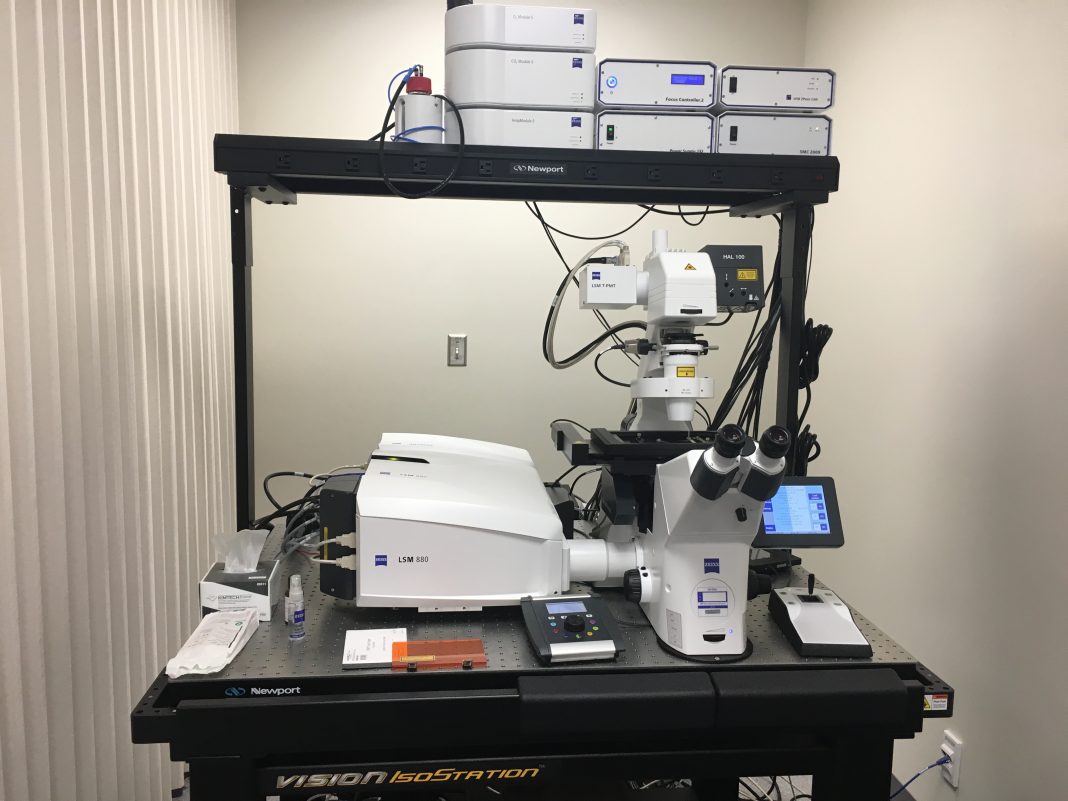Written by: Henry Tran, Coordinating News Editor
After buying the right microscope, SFU scientists can now get a much closer look at what’s happening inside a live cell.
In Fall 2018, scientists from SFU’s Centre for Cell Biology, Development and Disease (C2D2) gained access to a novel $750,000 super-resolution microscope, the Zeiss AiryScan. This system lets them visualize the complex processes that occur within living cells. C2D2 is a network of researchers at SFU who are performing cutting-edge biomedical research.
Ever since the 2014 Nobel Prize in Chemistry was awarded to a group of researchers who invented the “super-resolution fluorescence microscopy,” super-resolution microscopes are becoming more common at Canadian institutions that conduct biomedical, molecular, and cell biology-related research, according to Dr. Christopher Beh, a professor in the department of molecular biology and biochemistry and one of the 11 co-applicants who acquired the new gadget.
This new microscope is one of the best instruments for live cell imaging, offering users the ability to observe “the true dynamics of the cell,” said Beh in an email interview with The Peak. The new microscope is currently housed in the microscopy facility at SFU, which is located at the South Science Building, room 7145.
The new microscope was funded by the Natural Sciences and Engineering Research Council (NSERC) Research Tools and Instruments Grants Program, as well as the combined efforts of SFU’s office of the vice-president research, the Faculty of Health Sciences, the Faculty of Science, and several other departments, according to Beh.
“This type of microscopy permits visualization of large macromolecular complexes that reside within living cells. These are in essence the machines of life,” explained Beh. “Because we can see these very small things in living cells, we can also watch in 3 dimensions where within

Gathering the resources to obtain the novel microscope took a couple of years and a room in the microscopy facility had to be renovated, said Beh. Air conditioners also had to be installed to negate the heat generated by the super microscope.
The room also had to be “vibration dampened,” he added, as even a bus driving by on an outside street can vibrate enough to distort the microscope’s imaging.
Currently, properly trained personnel from SFU research labs as well as local biotech companies can use the Zeiss AiryScan through the microscopy facility for a fee. Beh did not disclose the exact amount, but he stated that the fee will be different for SFU research personnel compared to researchers from external organizations. Undergraduates working in research labs can also have access to it depending on completion of required training, explained Beh.
The super-resolution microscope can discern between two objects at a distance of less than 100 nm apart (a nanometer is 109 times smaller than a meter). The wavelength of green light is approximately 300 nm and this microscope has the capacity to capture objects much smaller than the wavelength of light, said Beh.
Traditional microscopes only discern objects around 150 nm apart, a visual limitation set by the Abbe diffraction limit in optical physics. Super-resolution microscopes can overcome this barrier, allowing researchers a greater visualization of the cell’s interior processes, explained Beh.
“We can see molecular motors moving up and down cytoskeletal ‘tracks,’ we can see membrane vesicles move lipids and proteins from where they are made in one internal membrane to another . . . In essence, we can see biological machines within the cell assemble and disassemble in a way we could never before,” he stated.
The new microscope will help Beh advance his research on membrane transport within cells and how pathologies like cancer and amyotrophic lateral sclerosis can develop when these intracellular mechanisms are disrupted.
The new microscope will also be used by multiple researchers across SFU, including but not limited to molecular cardiac physiologists, cellular neuroscientists, and virologists




